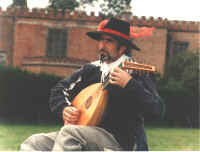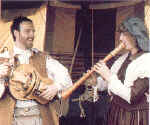
- The Siege group
- Home
- Who we are
- Living History
- On the Camp
- Costume
- 2007 Events
- News
- Membership info
- Picture Gallery
- Contact us
- Links
- Yahoo Group
- Site Credits
- The 17th Century
- Music
- Cookery
- Handicrafts
- Children
- Games
- Weaponry
- The Civil War
Music
Musical styles had become very diverse by the 17th century, from the folk tunes found in Playfords Country Dances, through sailors' shanties and soldiers' songs to the more elaborate consort music played for entertainment of the nobility.
The music was played on much the same instruments that had been around in the sixteenth century. Commonly, woodwind instruments like the flute and recorder, were popular for renaissance music. The three-hole pipe was also popular, the player having a free hand to play a drum, hung from the shoulder, with a stick.
The shawm was another type of woodwind instrument with a double-reed and produced a loud sound, ideal for outdoor music. String instruments such as fiddles and viols were used to play the folk-music of the time.
Keyboard instruments such as the virginal and spinet were also popular in 16th and 17th century Britain. They were types of harpsichord, a keyboard instrument that plucks the strings. The virginal was a small rectangular instrument, often called a 'pair of virginals'. The spinet differed in that it had a three sided cabinet. The harpsichord was the larger instrument of the keyboard family, often found in the more grander stately homes.
However, the lute remained the most popular instrument of the time.
The Lute
 The
lute had been around since the middle ages with five or six courses of
strings. By the end of the 16th century, 7-courses were very common.
The lute is a direct descendant of the Arabian Ud, brought back from
the crusades. Here is one of our members with his 7-course lute.
The
lute had been around since the middle ages with five or six courses of
strings. By the end of the 16th century, 7-courses were very common.
The lute is a direct descendant of the Arabian Ud, brought back from
the crusades. Here is one of our members with his 7-course lute.
Some of the best music for the lute was written during the Elizabethan age and is still played today. John Dowland is the best known English composer for the lute. He wrote many fine pieces before his death in 1626. Francis Cutting (1580-1600) wrote about 50 pieces for the lute, including a version of Greensleeves. Anthony Holborne, Daniel Batchelar, Philip Rosseter are all famous English composers for the lute.
During the 17th century, more courses were added to the lute, 8, 9, 10,11,12,13, even 14 courses. Consequently, they became more difficult to play and musicians began to experiment with alternatives.
The vihuela and guitar had become popular in Spain and also the cittern had arrived. Their shape and fewer strings made them easier to play and they eventually began to replace the lute in Britain too.
Reproducing the sound
The sound of the lute is unique and modern guitarists are turning to the lute and the challenge of a different playing technique. It is better suited to the quiet indoors for solo or consort playing.
Some of the members of The Siege Group are amateur musicians and play for their own pleasure. They try to get together after some of the events and play period music. It may be Elizabethan but was probably still in the charts!.
 The
two musicians shown here are Rick and Helen, who perform under the name
of 'Hautbois' They often perform at English Heritage sites around the
country on many early instruments. The Siege Group have been fortunate
to have them featured at the same event on a few occasions. They have
a fine repertoire of early music played on reproductions of authentic
instruments.
The
two musicians shown here are Rick and Helen, who perform under the name
of 'Hautbois' They often perform at English Heritage sites around the
country on many early instruments. The Siege Group have been fortunate
to have them featured at the same event on a few occasions. They have
a fine repertoire of early music played on reproductions of authentic
instruments.
Our lutenist shown at the top of this page, made his lute in 1995, from a book written by Ian Harwood. It represents a 16th century lute similar to those made by Hieber. It has 9 sycamore ribs, a 60cm mensur (playing length), and 7 courses (6 pairs of strings in unison tuning and 1 chanterelle). It is in G tuning, popular for this size of lute.
If you have a guitar, tune the 3rd string down to F#, then place a capo at the 3rd fret to experience this tuning. Lutes are expensive and many guitarists use this method until they can buy or make one.
All the music written for the lute was in tablature. 'French tablature' is the most common, where six lines represent the courses. Letter 'a', indicates an 'open' string and the other letters b, c, d etc. represent the stops (frets) along the fingerboard.
If you would like to learn to play lute-music, there are sites on the internet where tablature can be down-loaded. It has been reproduced from the exact notes written by composers 300-400 years ago. You may need to download another program first. Some programs can play it to you as a midi-sequence. Then you can hear the unique 'counter-point' of bass and treble melodies intermingling. Almost like a duet, but it is just one instrument being played.
See if you can find some recordings of lute music for a taste of this beautiful instrument's sound. They may be listed under Early Music in the classical section of your record store or library.